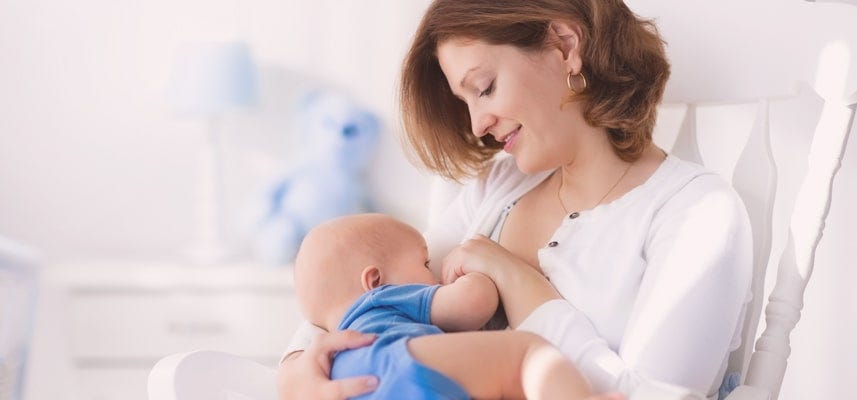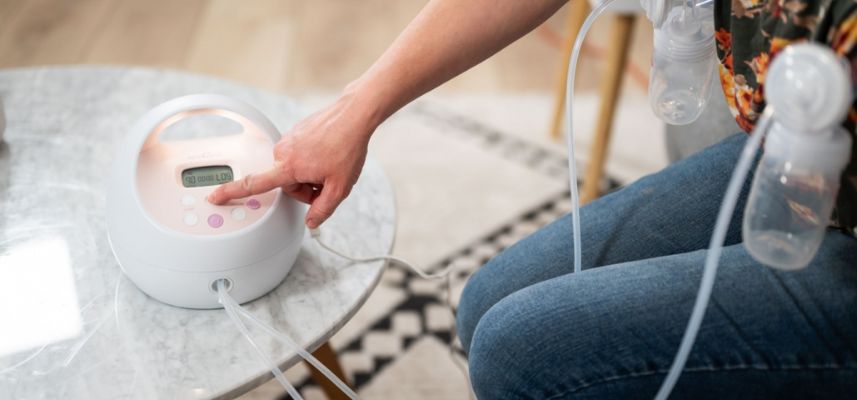Pooping for the first time after delivery stinks.
Jokes aside, many people find themselves anxious for their first postpartum bowel movement. It’s understandable! After all, delivering a baby causes a lot of sensitivity, soreness, and strain in the pelvic floor, and the horror stories from other mamas don’t help.
But there is no reason to panic! It’s okay to be a bit nervous, but we are here to support you and help you prepare for what to expect. From pain and constipation to everything in between, here’s our guide to help you survive that first postpartum poop:
Where the Problems Start
To set your expectations for the postpartum bathroom experience, it helps to understand how your body—particularly your GI tract—has changed during pregnancy. The hormonal and muscular changes of pregnancy and delivery significantly alter your digestive system's landscape.
The hormone progesterone is at its highest level by the time you give birth. And because it relaxes the muscles of the digestive tract and slows your digestion, this can cause discomfort, stomach aches, cramps, and notably, constipation.
The physical and emotional stresses of labor, delivery, and the early days after birth also trigger an increase in cortisol, which can also affect how often you go.
Your abdominal muscles are important for “bearing down” to pass a bowel movement. But over the last nine months, those muscles have been stretched to accommodate your growing baby. This can lead to abdominal pain, weakening, and soreness after birth, causing these muscles to be less effective when you’re trying to poop. If you’re already constipated from pain medications or iron supplements you received in the hospital, you may struggle even more.
Vaginal birth can put your pelvic floor through a lot (but you don’t need us to tell you that). As a result, bathroom breaks will feel much more sensitive than they did before birth, and this can be especially noticeable during the all-important number two.
Hemorrhoids and wounds from perineal tears can also compound to worsen issues. Keeping up on your hydration and ensuring proper nutrition become very important at this time for smoothing out this admittedly uncomfortable post-birth conquest.
Why Number Two Is Important, Too
Our most important recommendation for new moms tackling the bathroom beast: Monitor all your attempts to poop, even if they aren’t ultimately successful. Over half of all new moms experience postpartum constipation, so remember that if you can’t get things going, you aren’t alone!
If you haven't had a bowel movement by the fourth day after delivery, or if you feel extreme discomfort, contact your health care professional. You and your healthcare team should address persistent constipation sooner rather than later so it doesn't lead to a more concerning medical complication.
Monitoring your postpartum poops will also help you watch for signs of other possible complications. Stools that are bright red or black and tarry indicate possible internal bleeding and are a red flag: if you notice this, seek immediate medical attention.
Here are a few proactive steps you can take to promote healthier, more comfortable postpartum poops:
- Increase water intake. Hydration is key for softer stools! Make sure you drink plenty of water (8-10 glasses a day!) to hydrate your body and help relieve constipation.
- Eat high-fiber foods. You should also try to eat foods that are high in dietary fiber. Highly processed, refined foods tend to be higher in sugar and white flour, which can lead to harder stools and constipation. Incorporating fiber-rich foods (or even fiber supplements) aids in digestion and helps make your stools easier to pass.
- Experiment with body positioning. Certain body positions can make it easier to pass stools! Some moms report more success when using a stool (like a Squatty Potty) or leaning forward.
- Try stool softeners. Many postpartum people find that over-the-counter stool softeners help them beat postpartum constipation. Be sure to talk with your health care provider before starting any new medications or supplements.
- Get some rest! While this is easier said than done when you have a newborn, rest is the body’s number one way to recover and rehabilitate. Getting enough sleep can help your digestive system get on the right track.
- Move around. Light movement like walking can help jumpstart the digestive system. Be sure to talk to your doctor about what movement is right for you.
- Try pelvic floor physical therapy. Pelvic physical therapy is invaluable for everyone who has given birth, even if constipation isn’t a major issue. For people struggling to poop after delivery, pelvic PTs can help you find pain relief and retrain the muscles you use for an effective bowel movement. Pelvic physical therapists are in high demand, so booking a postpartum check-up before birth will make it easier to get help when you need it most.
Gently caring for your body after giving birth will support a smoother recovery and allow you to focus more on the joy of new motherhood!
The Opposite End of the Spectrum
While some mothers struggle with constipation after delivery, many others experience the opposite—but equally distressing—problem: postpartum diarrhea and/or bowel incontinence. This is also common and treatable! These symptoms may be from stretching or tearing of the rectal muscles during delivery.
Though it may sound counterintuitive, many of the same tips recommended for constipation can help you manage postpartum diarrhea. Gut-healthy, high-fiber foods help increase the bulk of your stools, making them more solid and easier to pass. Proper hydration, particularly if you’re losing fluid through breastfeeding, is important to combat the dehydration diarrhea can cause.
If you have persistent diarrhea for more than a few days after birth, contact your health care provider for specific advice and treatment. Always consult with your doctor before beginning any anti-diarrheal medications, even if you buy them over the counter.
Fecal Incontinence
Vaginal delivery stretches and stresses the pelvic floor muscles. This stress can range from mild to severe, and as a result, some postpartum people experience postpartum bowel incontinence. This condition is also known as fecal or anal incontinence, and the severity of the symptoms can range from the inability to hold back gas to complete loss of bowel control. Approximately 5-25% of postpartum people will experience some degree of anal incontinence.
Thankfully, there are interventions to help you rehabilitate your pelvic floor muscles and regain continence. A pelvic physical therapist can teach you exercises to rebuild the strength and control of your pelvic floor. It's not just about kegels; a personalized exercise regimen can optimize your postpartum recovery and help you feel more confident in your postpartum body.
How To Manage Pain
If you are experiencing pain during bowel movements, here are some ways to manage your discomfort:
- Sitz Baths: A sitz bath can be a great way to relieve perineal discomfort, even if it’s not directly related to pooping. The warm water soothes and facilitates healing around the anus. Note that a sitz bath is not the same as a traditional bath. Avoid submerging your whole body in a bathtub until your health care provider gives you the go-ahead.
- Cold Therapy: Cold packs can soothe hemorrhoids and perineal inflammation that are common after delivery. Try soaking a menstrual pad in clean water and freezing it, and then apply the frozen pack over a thin layer of clothing for 10-15 minutes.
- Relaxation: Find your zen. Practicing meditation and relaxation on the toilet can help your pelvic floor muscles relax fully and allow the passage of stool. Avoid the temptation to scroll on your phone, and instead enjoy these few minutes of peace and quiet to take some time for yourself.
If you experience severe pain while pooping, or you think you have hemorrhoids or anal fissures, reach out to your health care provider. They can provide guidance and help you get some extra relief.
When To Call Your Doctor
When lifestyle adjustments and over-the-counter remedies (as approved by your doctor), aren’t helping ease your postpartum poos, it’s time to seek medical attention.
Here are some red flags that should prompt you to call to your doctor:
- Extreme anal or abdominal pain and/or bleeding
- Blood in your stools (indicated by bright red or black, tarry appearance)
- Prolonged constipation or diarrhea (more than a few days to a week)
- Severe abdominal cramps and bloating, which may indicate a more severe condition
If your bowel movements remain painful after the first week or two post-delivery, you may have an underlying complication that needs medical evaluation. Don’t be shy: call your health care provider and ask for help!
Use your routine postnatal checkup, typically scheduled between two to six weeks post-delivery, as an opportunity to discuss any persistent bowel issues with your health care provider. It’s always better to play it safe and ensure that minor problems don’t develop into chronic conditions.
Will I need surgery?
In rare cases, surgical repair is necessary to correct severe perineal tears and other complications that are interfering with normal bowel function. Fortunately, most women find that their bowel function returns to normal with the help of the treatments we’ve already discussed.
Got all that? Now you’re the resident postpartum poop expert!
Once you conquer that first postpartum poop, you are that much closer to consistent, regular bowel movements. While it’s normal to be a bit nervous, we hope we have demystified some of the horror stories and old wives’ tales you may have heard. You’ve got this, mama!
References
https://my.clevelandclinic.org/health/body/24562-progesterone
https://www.ncbi.nlm.nih.gov/pmc/articles/PMC3904305/
https://www.ncbi.nlm.nih.gov/pmc/articles/PMC9132325/
https://www.healthline.com/health/opioid-induced-constipation
https://www.mayoclinic.org/healthy-lifestyle/labor-and-delivery/in-depth/vaginal-tears/art-20546855
https://pubmed.ncbi.nlm.nih.gov/33030260/
https://www.webmd.com/baby/what-to-know-about-postpartum-constipation
https://www.bladderandbowel.org/help-information/resources/toilet-positions/
https://www.ncbi.nlm.nih.gov/pmc/articles/PMC3093001/
https://www.webmd.com/digestive-disorders/exercise-curing-constipation-via-movement
https://www.ajog.org/article/S0002-9378(22)02167-6/fulltext
https://www.babycenter.com/baby/postpartum-health/postpartum-anal-incontinence_1157264
https://www.mayoclinic.org/diseases-conditions/anal-fissure/symptoms-causes/syc-20351424
https://obgyn.onlinelibrary.wiley.com/doi/abs/10.1111/1471-0528.16559
https://www.mayoclinic.org/diseases-conditions/postpartum-preeclampsia/symptoms-causes/syc-20376646











